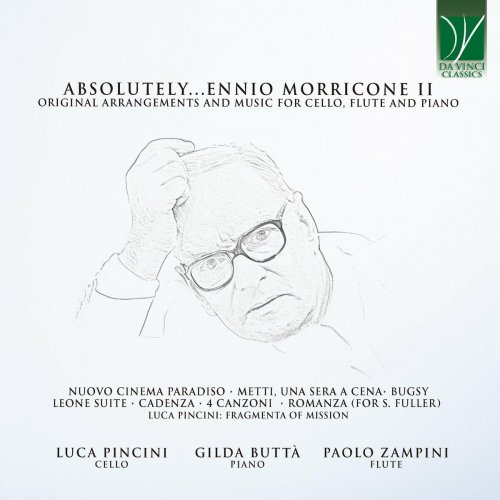
Gilda Buttà - Absolutely...Morricone II (Original Arrangements and Music for Cello, Flute and Piano) (2024)
BAND/ARTIST: Gilda Buttà, Paolo Zampini, Luca pincini
- Title: Absolutely...Morricone II (Original Arrangements and Music for Cello, Flute and Piano)
- Year Of Release: 2024
- Label: Da Vinci Classics
- Genre: Classical
- Quality: FLAC (tracks)
- Total Time: 60:20 min
- Total Size: 238 MB
- WebSite: Album Preview
Tracklist|
01. Nuovo Cinema Paradiso, for piano
02. Metti, una sera a cena, for flute and piano
03. Rag in frantumi, for piano
04. Bugsy, for flute and piano
05. Leone Suite, for cello and piano: No. 1, Deborah’s theme
06. Leone Suite, for cello and piano: No. 2, Cockeye’s song
07. Leone Suite, for cello and piano: No. 3, Main theme
08. Leone Suite, for cello and piano: No. 4, Once upon a time in the West
09. Leone Suite, for cello and piano: No. 5, The Ecstasy of Gold
10. Cadenza for flute and magnetic tape
11. 4 Canzoni, for piano: No. 1, Il deserto dei Tartari
12. 4 Canzoni, for piano: No. 2, Le due stagioni della vita
13. 4 Canzoni, for piano: No. 3, Gott mitt uns
14. 4 Canzoni, for piano: No. 4, Il potere degli angeli
15. Fragmenta of Mission, for cello
16. Romanza, for cello and piano
01. Nuovo Cinema Paradiso, for piano
02. Metti, una sera a cena, for flute and piano
03. Rag in frantumi, for piano
04. Bugsy, for flute and piano
05. Leone Suite, for cello and piano: No. 1, Deborah’s theme
06. Leone Suite, for cello and piano: No. 2, Cockeye’s song
07. Leone Suite, for cello and piano: No. 3, Main theme
08. Leone Suite, for cello and piano: No. 4, Once upon a time in the West
09. Leone Suite, for cello and piano: No. 5, The Ecstasy of Gold
10. Cadenza for flute and magnetic tape
11. 4 Canzoni, for piano: No. 1, Il deserto dei Tartari
12. 4 Canzoni, for piano: No. 2, Le due stagioni della vita
13. 4 Canzoni, for piano: No. 3, Gott mitt uns
14. 4 Canzoni, for piano: No. 4, Il potere degli angeli
15. Fragmenta of Mission, for cello
16. Romanza, for cello and piano
The catalog of Ennio Morricone (1928 – 2020) encompasses nearly five hundred film soundtracks. This record-breaking number, perhaps unparalleled, unquestionably positions him as one of the most significant composers in the history of film music. Beyond sheer quantity, it is the qualitative aspects that stand out: the solidity of his composition, the expressive power of his themes, his exploration of timbral qualities, and a propensity for experimentation. Moreover, his masterpieces created in collaboration with Sergio Leone, from “A Fistful of Dollars” to “Once Upon a Time in America,” remain untouched by the passage of time and continue to captivate transgenerational and international audiences to this day.
Crowned with two Oscars and numerous accolades, Morricone’s cinematic career commenced in 1961 and continued for over half a century. In addition to Leone, his long-lasting partnership with Giuseppe Tornatore played a fundamental role, yet his collaborations with Pier Paolo Pasolini, Elio Petri, Bernardo Bertolucci, Giuliano Montaldo, Gillo Pontecorvo, Dario Argento, and, on an international scale, Brian De Palma, Roland Joffé, John Carpenter, William Friedkin, Quentin Tarantino are also noteworthy. These names represent only a few of the many directors with whom he cooperated.
However, Morricone’s production extends far beyond his “applied” music. His catalog comprises approximately 130 compositions intended for the concert hall: symphonic scores, choral works, chamber music, and pieces for solo instruments. He referred to these as “absolute” music, emphasizing their independence from visual imagery and their stylistic autonomy. This represents a creative realm in which he could fully leverage the lessons learned from Goffredo Petrassi during his conservatory years and explore the experimental inclination he shared with many composers of his generation. While many considered these two aesthetics and languages irreconcilable, Morricone attempted to bridge them, often succeeding in achieving a harmonious convergence.
Crowned with two Oscars and numerous accolades, Morricone’s cinematic career commenced in 1961 and continued for over half a century. In addition to Leone, his long-lasting partnership with Giuseppe Tornatore played a fundamental role, yet his collaborations with Pier Paolo Pasolini, Elio Petri, Bernardo Bertolucci, Giuliano Montaldo, Gillo Pontecorvo, Dario Argento, and, on an international scale, Brian De Palma, Roland Joffé, John Carpenter, William Friedkin, Quentin Tarantino are also noteworthy. These names represent only a few of the many directors with whom he cooperated.
However, Morricone’s production extends far beyond his “applied” music. His catalog comprises approximately 130 compositions intended for the concert hall: symphonic scores, choral works, chamber music, and pieces for solo instruments. He referred to these as “absolute” music, emphasizing their independence from visual imagery and their stylistic autonomy. This represents a creative realm in which he could fully leverage the lessons learned from Goffredo Petrassi during his conservatory years and explore the experimental inclination he shared with many composers of his generation. While many considered these two aesthetics and languages irreconcilable, Morricone attempted to bridge them, often succeeding in achieving a harmonious convergence.
Year 2024 | Classical | FLAC / APE
As a ISRA.CLOUD's PREMIUM member you will have the following benefits:
- Unlimited high speed downloads
- Download directly without waiting time
- Unlimited parallel downloads
- Support for download accelerators
- No advertising
- Resume broken downloads



